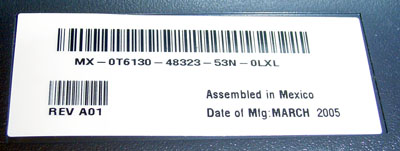The 20" LCD Shootout: Dell versus Apple
by Kristopher Kubicki on April 27, 2005 12:05 AM EST- Posted in
- Displays
Concerning the 2005FPW Image Quality
When the UltraSharp 2005FPW debuted circa November 2004, several of our forum members promptly bought several units without hesitation. Many readers in response emailed us with complaints, and several forum threads illustrated the debacle. It seemed to us that there were three main complaints:- The Dell UltraSharp 2005FPW had severe discoloration, particularly with red hues.
- The Dell UltraSharp 2005FPW had severe screen uniformity problems.
- The Dell UltraSharp 2005FPW had problems obtaining/holding DVI signals at 1680x1050.
Screen discoloration, particularly "warm" colors, occurs for many different reasons. Perhaps the largest reason why we see such discoloration is due to the use of a poorly shielded or a heavily interfered 15-pin D-sub connector. At 1680x1050 resolutions (native for the Apple 20" and Dell 2005FPW), so much analog bandwidth is moving over the cable that it becomes very easy for the signal to become unstable. Generally, this results in the whole screen discoloring, but we have witnessed incidents where the strangest interference will discolor only a portion of the screen. The interconnects between the LCD panel and the monitor PCB could also have some interference along them, or even worse, they may be damaged/unset. In our experience with the Dell 2005FPW, when any of these cables were unset, the monitor backlights quickly switched off. The third culprit may have been the Genesis controller itself, although we would expect the whole screen to discolor as opposed to a small blurry portion. Glare and lighting effects also play their portion of tricks on the eye, and we have diagnosed more than one discoloration problem as reflections from unusual sources.
Poor screen uniformity is almost always a product of construction; either the unit was handled improperly or assembled incorrectly. We feel that this is the most severe of all three of the problems, since its almost impossible for the end user to misdiagnose this (unless people are tossing their 2005FPWs on the ground and then sending us pictures just for kicks!).
The last problem troubles us a little, although it can be generally attributed to a poor video card or a poor cable. After working very closely with Silicon Image over the last few months, it has come to our attention that several DVI video outputs and cables are surprisingly low quality. Unlike analogy D-sub cables, a poor DVI signal will just cause the monitor's DSP to ignore the signal. It may be that the Genesis gm1501 chips produced in the last few months have lower tolerances for faulty signals - or it may just be the case that we didn't have any reported cases of the DVI signal problem on older 2005FPW displays.

In our opinion, the fear of Dell UltraSharp 2005FPW image quality may have been a little exaggerated. Although the Apple Cinema displays use the same panels as their Dell counterparts, we never heard a single case of a defective Cinema 20" display. However, do consider the fact that the Apple uses much simplier signal processing and only on a digital source. Also keep in mind that the Cinema displays are also relatively easier for quality assurance; Apple hardware is scrutinized much harder than typical PC hardware - thus, video cards and cabling are more likely to work 100% correctly. The fact that UltraSharp 2005FPW has analog inputs most likely attributed to the early problems mentioned above.











70 Comments
View All Comments
sandys - Wednesday, April 27, 2005 - link
Oh yeah and as for panel manufacturer it can only be Samsung, not seen anyone else doing one. probably the ltm240w1http://www.samsung.com/Products/TFTLCD/common/prod...
pure guesswork of course :p
Gatak - Wednesday, April 27, 2005 - link
#36, It is about contrast. The eyes are strained if you have a bright light in just a part of the field of view. The strain comes from having to both adjust for the bright light _and_ at the same time allow enough light to come from the darker areas. In other words it is difficult for the eyes to properly acclimate to the lighting situation.sandys - Wednesday, April 27, 2005 - link
Hi JNo,The 2405 can be bought in the UK, for some reason it is not showing on Dells site but you can still phone them and buy it so answers to questions
a) yes it supports 1:1 pixel mapping
b) it can be bought but price varies depending on offer at the time, I bought two and got one half price plus 20% off bring each to £540 which was a bargain, others have got around 600-693 for a single unit.
c) yes it can.
The 2405 also has component and I run my PS2 and xbox off of it, unfortunately we get stiffed a bit in the UK and box Sony and MS remove the useful progressive resolutions in place of interlaced so the only way to get a quality output on Xbox is to mod it and switch it to NTSC and for the PS2 buy US games or live with 576i :(
look here www.hdtvarcade.com
Cheers
xsilver - Wednesday, April 27, 2005 - link
#31obviously to "fix" a dark room you just turn on the light... but I wanted to know more about the principles behind it.... what makes the monitor so different when its used in a dark room?
why is it so bad to turn down the brightness?
why does it hurt your eyes? (cause it doesnt hurt mine)
Zak - Wednesday, April 27, 2005 - link
Doom3 and Trainz configs can also be edited to support 1680x1050.Zak
ir0nw0lf - Wednesday, April 27, 2005 - link
Don't forget that World of Warcraft natively supports 1680x1050!!bob661 - Wednesday, April 27, 2005 - link
#21I won't buy a LCD either, yet. I do have a Viewsonic VP201b (supposedly the same panel as the Dell 2001FP) and it was VERY good playing UT2004 and Doom 3. I'll wait for two more generations of LCD AND then I'll some more for those to come down into the $300 range for a 19 or 20".
DestruyaUR - Wednesday, April 27, 2005 - link
Will these new 23 and 30" samples you speak of have HDCP circuitry so they could actually be used as TVs?Gatak - Wednesday, April 27, 2005 - link
#9: Easy to fix. Increase ambient light in the room. It is usually never good to work in a dark room. The "White" on the screen should also be the same color temperature as the ambient light.TinyTeeth - Wednesday, April 27, 2005 - link
Great review, but you really should use a better camera... :X